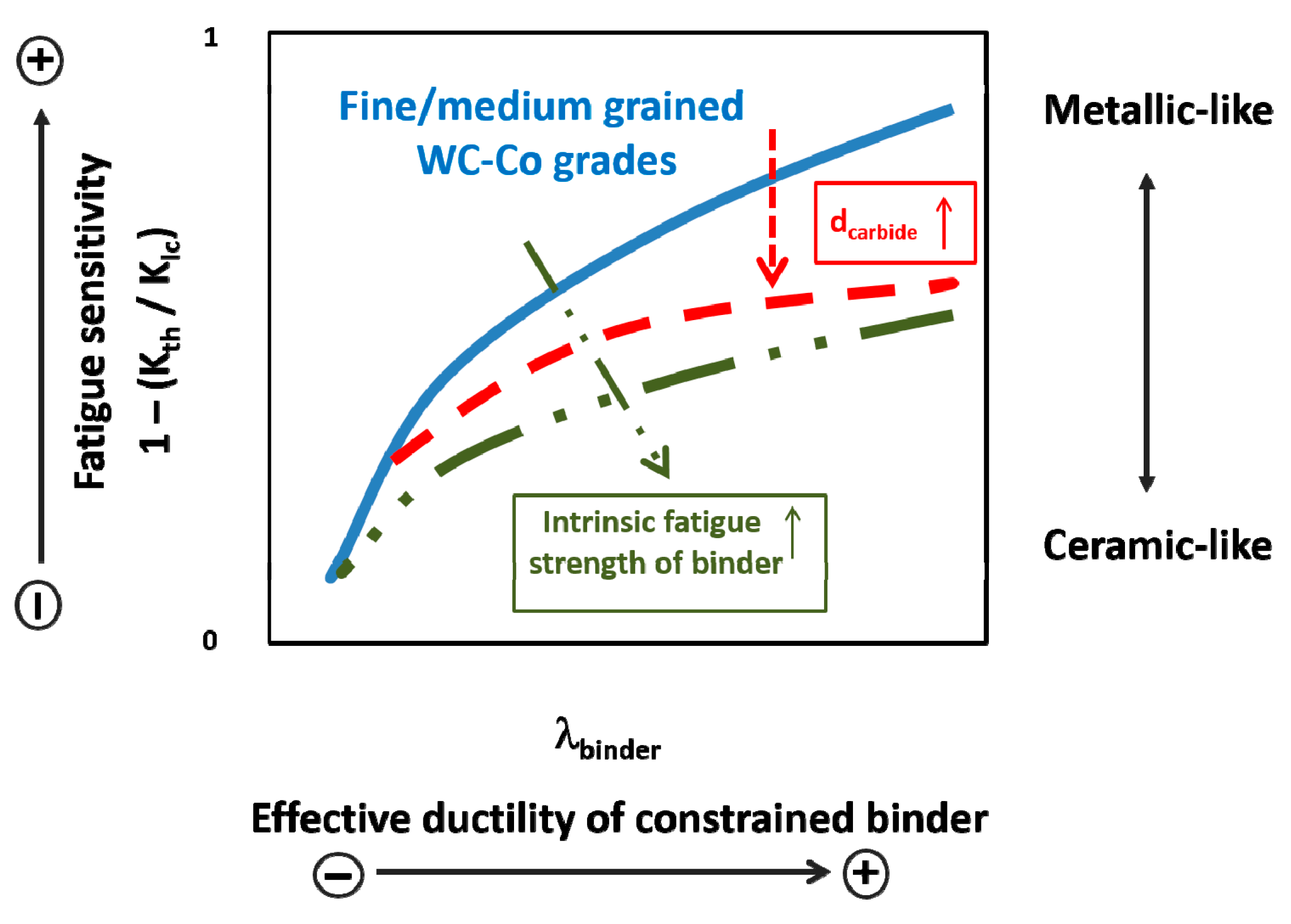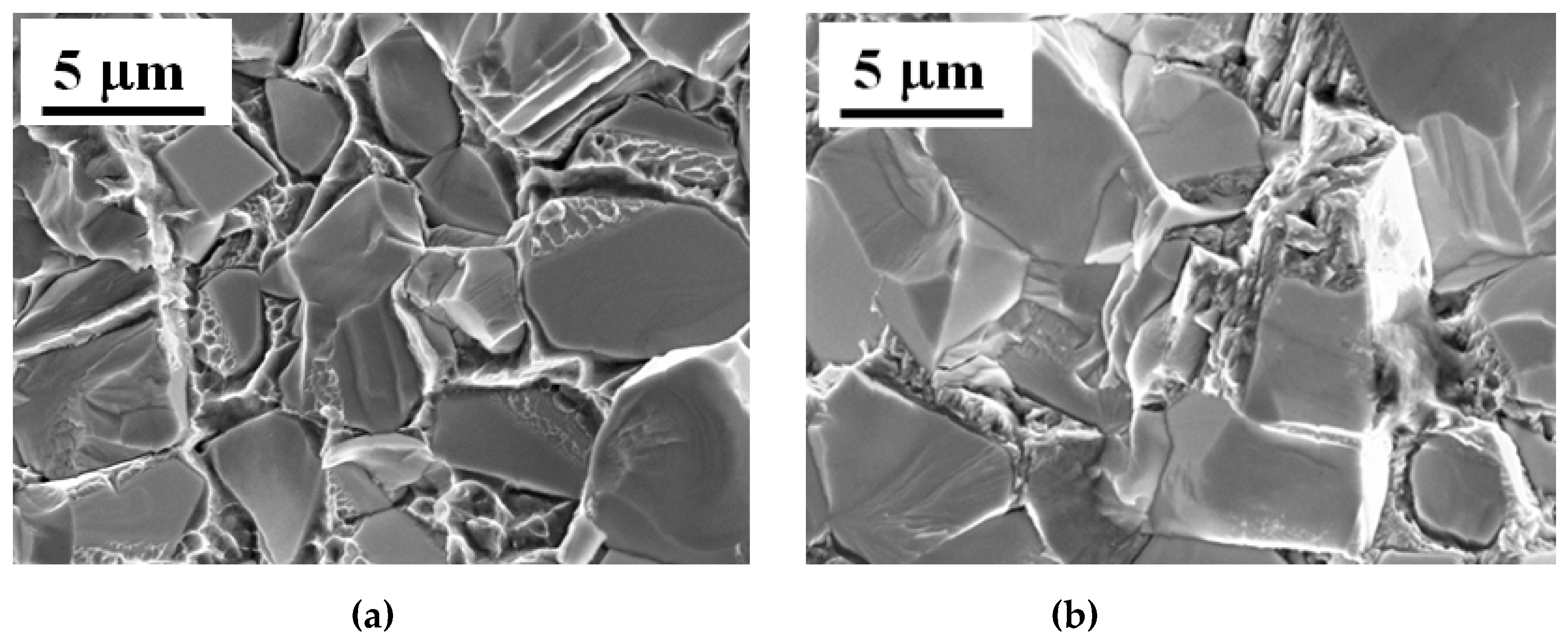In-Depth Understanding of Fatigue Micromechanisms in Cemented Carbides: Implications for Optimal Microstructural Tailoring †
Abstract
1. Introduction
2. Fatigue Mechanics
3. Fatigue Sensitivity
4. Crack–Microstructure Interaction under Monotonic and Cyclic Loading
5. Summary
Funding
Acknowledgments
Conflicts of Interest
References
- Sarin, V.K.; Mari, D.; Llanes, L. Comprehensive Hard Materials; Elsevier Ltd.: Oxford, UK, 2014; Volume 1, pp. 1–538. [Google Scholar]
- Dawihl, W. Die wissenschaftlichen und technischen grudlagen der pulvermetallurgic und ihrer anwendungsbereiche. Stahl Eisen 1941, 61, 909–919. [Google Scholar]
- Schleinkofer, U.; Sockel, H.-G.; Görting, K.; Heinrich, W. Microstructural processes during subcritical crack growth in hard metals and cermets under cyclic loads. Mater. Sci. Eng. A 1996, 209, 103–110. [Google Scholar] [CrossRef]
- Schleinkofer, U.; Sockel, H.G.; Gorting, K.; Heinrich, W. Fatigue of hard metals and cermets. Mater. Sci. Eng. A 1996, 209, 313–317. [Google Scholar] [CrossRef]
- Kursawe, S.; Pott, P.; Sockel, H.; Heinrich, W.; Wolf, M. On the influence of binder content and binder composition on the mechanical properties of hardmetals. Int. J. Refract. Met. Hard Mater. 2001, 19, 335–340. [Google Scholar] [CrossRef]
- Sailer, T.; Herr, M.; Sockel, H.-G.; Schulte, R.; Feld, H.; Prakash, L. Microstructure and mechanical properties of ultrafine-grained hardmetals. Int. J. Refract. Met. Hard Mater. 2001, 19, 553–559. [Google Scholar] [CrossRef]
- Torres, Y.; Anglada, M.; Llanes, L. Fatigue mechanics of WC–Co cemented carbides. Int. J. Refract. Met. Hard Mater. 2001, 19, 341–348. [Google Scholar] [CrossRef]
- Llanes, L.; Torres, Y.; Anglada, M. On the fatigue crack growth behavior of WC-Co cemented carbides: Kinetics description, microstructural effects and fatigue sensitivity. Acta. Mater. 2002, 50, 2381–2393. [Google Scholar] [CrossRef]
- Llanes, L.; Anglada, L.; Torres, M.Y. Fatigue of cemented carbides. In Comprehensive Hard Materials; Sarin, V.K., Mari, D., Llanes, L., Eds.; Elsevier Ltd.: Oxford, UK, 2014; Volume 1, pp. 345–362. [Google Scholar]
- Almond, E.A.; Roebuck, B. Fatigue-crack growth in WC–Co hardmetals. Met. Technol. 1980, 2, 83–85. [Google Scholar] [CrossRef]
- Fry, P.R.; Garrett, G.G. Fatigue crack growth behaviour of tungsten carbide-cobalt hardmetals. J. Mater. Sci. 1988, 23, 2325–2338. [Google Scholar] [CrossRef]
- Sigl, L.S.; Exner, H.E. Experimental study of the mechanics of fracture in WC-Co alloys. Met. Mater. Trans. A 1987, 18, 1299–1308. [Google Scholar] [CrossRef]
- Tarragó, J.M.; Jiménez-Piqué, E.; Turón-Viñas, M.; Rivero, L.; Al-Dawery, I.; Schneider, L.; Llanes, L. Fracture and fatigue behavior of cemented carbides: 3D focused ion beam tomography of crack-microstructure interactions. Int. J. Powder Metall. 2014, 50, 1–10. [Google Scholar]
- Tarragó, J.; Jimenez-Pique, E.; Schneider, L.; Casellas, D.; Torres, Y.; Llanes, L. FIB/FESEM experimental and analytical assessment of R-curve behavior of WC–Co cemented carbides. Mater. Sci. Eng. A 2015, 645, 142–149. [Google Scholar] [CrossRef]
- Tarragó, J.; Ferrari, C.; Reig, B.; Coureaux, D.; Schneider, L.; Llanes, L. Mechanics and mechanisms of fatigue in a WC–Ni hardmetal and a comparative study with respect to WC–Co hardmetals. Int. J. Fatigue 2015, 70, 252–257. [Google Scholar] [CrossRef]
- Tarragó, J.; Roa, J.; Valle, V.; Marshall, J.; Llanes, L. Fracture and fatigue behavior of WC–Co and WC–CoNi cemented carbides. Int. J. Refract. Met. Hard Mater. 2015, 49, 184–191. [Google Scholar] [CrossRef]
- Sergejev, F.; Preis, I.; Kubarsepp, J.; Antonov, M. Correlation between surface fatigue and microstructural defects of cemented carbides. Wear 2008, 264, 770–774. [Google Scholar] [CrossRef]
- Klünsner, T.; Marsoner, S.; Ebner, R.; Pippan, R.; Glätzle, J.; Püschel, A. Effect of microstructure on fatigue properties of WC-Co hard metals. Procedia Eng. 2010, 2, 2001–2010. [Google Scholar] [CrossRef]
- Kotas, A.B.; Danninger, H.; Weiss, B.; Mingard, K.; Sanchez, J.M.; Llanes, L. Fatigue testing and properties of hardmetals in the gigacycle range. Int. J. Refract. Met. Hard Mater. 2017, 62, 183–191. [Google Scholar] [CrossRef]
- Roebuck, B.; Maderud, C.; Morrell, R. Elevated temperature fatigue testing of hardmetals using notched testpieces. Int. J. Refract. Met. Hard Mater. 2008, 26, 19–27. [Google Scholar] [CrossRef]
- Ferreira, J.; Amaral, M.P.; Antunes, F.; Costa, J.; Antunes, F. A study on the mechanical behaviour of WC/Co hardmetals. Int. J. Refract. Met. Hard Mater. 2009, 27, 1–8. [Google Scholar] [CrossRef]
- Li, A.; Zhao, J.; Wang, D.; Gao, X.; Tang, H. Three-point bending fatigue behavior of WC–Co cemented carbides. Mater. Des. 2013, 45, 271–278. [Google Scholar] [CrossRef]
- Mikado, H.; Ishihara, S.; Oguma, N.; Kawamura, S. On the Short Surface Fatigue Crack Growth Behavior in a Fine-Grained WC-Co Cemented Carbide. Metals 2017, 7, 254. [Google Scholar] [CrossRef]
- Liu, S.-Y.; Chen, I.-W. Fatigue of yttria–stabilized zirconia: I—Fatigue damage, fracture origins, and lifetime prediction. J. Am. Ceram. Soc. 1991, 74, 1197–1205. [Google Scholar] [CrossRef]
- Steffen, A.A.; Dauskardt, R.H.; Ritchie, R.O. Cyclic Fatigue Life and Crack-Growth Behavior of Microstructurally Small Cracks in Magnesia-Partially-Stabilized Zirconia Ceramics. J. Am. Ceram. Soc. 1991, 74, 1259–1268. [Google Scholar] [CrossRef]
- Torres, Y.; Tarragó, J.; Coureaux, D.; Tarrés, E.; Roebuck, B.; Chan, P.; James, M.; Liang, B.; Tillman, M.; Viswanadham, R.; et al. Fracture and fatigue of rock bit cemented carbides: Mechanics and mechanisms of crack growth resistance under monotonic and cyclic loading. Int. J. Refract. Met. Hard Mater. 2014, 45, 179–188. [Google Scholar] [CrossRef]
- Tarragó, J.; Coureaux, D.; Torres, Y.; Casellas, D.; Al-Dawery, I.; Schneider, L.; Llanes, L. Microstructural effects on the R-curve behavior of WC-Co cemented carbides. Mater. Des. 2016, 97, 492–501. [Google Scholar] [CrossRef]
- Fischmeister, H.; Schmauder, S.; Sigl, L. Finite element modelling of crack propagation in WC-Co hard metals. Mater. Sci. Eng. A 1988, 105, 305–311. [Google Scholar] [CrossRef]
- Erling, G.; Kursawe, S.; Luyckx, S.; Sockel, H.G. Stable and unstable fracture surface features in WC-Co. J. Mater. Sci. Lett. 2000, 19, 437–438. [Google Scholar] [CrossRef]
- Il Padula, S.A.; Shyam, A.; Ritchie, R.O.; Milligan, W.W. High frequency fatigue crack propagation behavior of a nickel-base turbine disk alloy. Int. J. Fatigue 1999, 21, 725–731. [Google Scholar] [CrossRef]
- Jiang, L.; Brooks, C.; Liaw, P.; Klarstrom, D.; Rawn, C.; Muenchen, B.; Muenchen, R. Phenomenological aspects of the high-cycle fatigue of ULTIMET® alloy. Mater. Sci. Eng. A 2001, 316, 66–79. [Google Scholar] [CrossRef]
- Chen, Q.; Kawagoishi, N.; Wang, Q.; Yan, N.; Ono, T.; Hashiguchi, G. Small crack behavior and fracture of nickel-based superalloy under ultrasonic fatigue. Int. J. Fatigue 2005, 27, 1227–1232. [Google Scholar] [CrossRef]
- Suresh, S. Fatigue of Materials, 1st ed.; Cambridge University Press: New York, NY, USA, 1991; pp. 190–221. [Google Scholar]
- Sigl, L.; Fischmeister, H. On the fracture toughness of cemented carbides. Acta Met. 1988, 36, 887–897. [Google Scholar] [CrossRef]
- Tarragó, J.; Roa, J.; Jimenez-Pique, E.; Keown, E.; Fair, J.; Llanes, L. Mechanical deformation of WC–Co composite micropillars under uniaxial compression. Int. J. Refract. Met. Hard Mater. 2016, 54, 70–74. [Google Scholar] [CrossRef]
- Roa, J.; Jimenez-Pique, E.; Tarragó, J.; Sandoval, D.A.; Mateo, A.; Fair, J.; Llanes, L. Hall-Petch strengthening of the constrained metallic binder in WC–Co cemented carbides: Experimental assessment by means of massive nanoindentation and statistical analysis. Mater. Sci. Eng. A 2016, 676, 487–491. [Google Scholar] [CrossRef]
- Naughton-Duszová, A.; Csanádi, T.; Sedlák, R.; Hvizdoš, P.; Dusza, J.; Duszová, N. Small-Scale Mechanical Testing of Cemented Carbides from the Micro- to the Nano-Level: A Review. Metals 2019, 9, 502. [Google Scholar] [CrossRef]
- Sandoval, D.A.; Rinaldi, A.; Notargiacomo, A.; Ther, O.; Tarrés, E.; Roa, J.; Llanes, L. Influence of specimen size and microstructure on uniaxial compression of WC-Co micropillars. Ceram. Int. 2019, 45, 15934–15941. [Google Scholar] [CrossRef]




© 2019 by the author. Licensee MDPI, Basel, Switzerland. This article is an open access article distributed under the terms and conditions of the Creative Commons Attribution (CC BY) license (http://creativecommons.org/licenses/by/4.0/).
Share and Cite
Llanes, L. In-Depth Understanding of Fatigue Micromechanisms in Cemented Carbides: Implications for Optimal Microstructural Tailoring. Metals 2019, 9, 924. https://doi.org/10.3390/met9090924
Llanes L. In-Depth Understanding of Fatigue Micromechanisms in Cemented Carbides: Implications for Optimal Microstructural Tailoring. Metals. 2019; 9(9):924. https://doi.org/10.3390/met9090924
Chicago/Turabian StyleLlanes, Luis. 2019. "In-Depth Understanding of Fatigue Micromechanisms in Cemented Carbides: Implications for Optimal Microstructural Tailoring" Metals 9, no. 9: 924. https://doi.org/10.3390/met9090924
APA StyleLlanes, L. (2019). In-Depth Understanding of Fatigue Micromechanisms in Cemented Carbides: Implications for Optimal Microstructural Tailoring. Metals, 9(9), 924. https://doi.org/10.3390/met9090924




